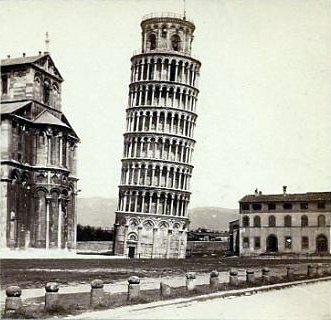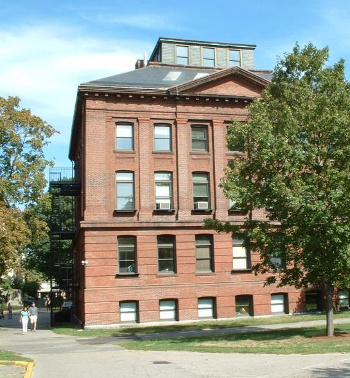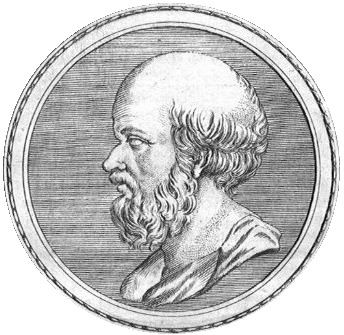Towers of Physics
August 12, 2011
Would
Pisa, Italy, be known to anyone outside its region if it were not for its famous
leaning tower? And would this
tower be known that well except for the famous
experiment on falling bodies by
Galileo that's usually depicted in one
cartoon or another? In actuality, the tower experiment may have been just a
thought experiment of Galileo's, but it was written as if it had actually occurred by one of his disciples,
Vincenzo Viviani.
Galileo, himself, wrote no record of such an experiment, perhaps because the result, that lighter objects fall just as fast as heavier ones, was contrary to what
Aristotle had written. Aristotle was considered by the
Church as the authority on all
scientific matters that didn't contradict the
Bible. Aristotle's philosophy was the official philosophy of the Church in Galileo's time, and if your science wasn't found in Aristotle, too bad for you, observational evidence notwithstanding.[1]

The Leaning Tower in Pisa, Italy.
This is the right image from a stereography, dated January 24, 1866. The tower did not lean as much in Galileo's day.
Photograph by Enrico van Lint (1808-1884), via Wikimedia Commons)
Galileo's experiment wasn't the only significant
physics experiment that involved dropping objects from towers. One other, published in 1903, involved a more direct demonstration of the
Coriolis effect than seen in the
Foucault pendulum, although that wasn't the primary purpose of the experiment. I wrote about the Foucault pendulum in a
previous article (A Foucault Gyroscope, February 14, 2011).
The
Coriolis force is the apparent force seen on a falling body that results from
Earth's rotation beneath the object. The net result is that objects land slightly eastwards from where they would be expected to land based on a
plumb line trajectory. The 1903 experiment, by
Edwin H. Hall of the eponymous
Hall effect, was designed to test a possible small deflection towards the south.[2-3] Quoting from Hall's 1903 paper,
"The question whether a sphere falling from rest through a few hundred feet of still air swerves perceptibly towards the south, from the vertical path indicated by the plumb line, is not, perhaps, one of the largest or more urgent problems of physics; but it has the dignity of venerable ages and the charm of mystery. It was familiar to Newton; it has been answered in the negative, on theoretical grounds, by Gauss and Laplace, and in the positive, on experimental grounds, by nearly every one of the investigators who have from time to time through more than two centuries made the actual trial."[2]
In his experiment, Hall dropped 948 one-inch metal balls through a distance of about twenty meters inside the left tower of
Harvard University's Jefferson Laboratory, pictured below. He found a 0.149 cm eastward deviation, which was slightly less than theoretical calculations, but assumed to be correct within the
experimental error. The southwards deviation that his experiment was designed to find was 0.0050 cm, or just about his experimental error. Hall's paper states no conclusion on the matter of southwards motion.[3]

The left tower of the Jefferson Laboratory, Harvard University, as it appears today.
Hall's ball drop experiment and the Pound-Rebka experiment were conducted here.
Photo by Lubos Motl, via Wikimedia Commons)
Another famous physics experiment was performed in that same Harvard tower by
Robert Vivian Pound and his graduate student,
Glen Rebka. The
Pound–Rebka experiment examined the
gravitational redshift of the
Mössbauer spectrum of
57Fe. It was a straightforward confirmation of
general relativity.[4-6]
Details of the experiment can be found in the references,[6-7] or as a
summary on Wikipedia. They reveal the various tricks used to coax a signal out of
noise. Just as for Hall's experiment, the measured effect was extremely small, being about a tenth percent of the
57Fe resonance linewidth.[5] Both the Hall experiment and the Pound–Rebka experiment show that attention to detail is the hallmark of the able
experimentalist.
As I summarized in a
previous article (Eratosthenes, March 17, 2011), there's one experiment that was performed much earlier than Galileo in which a tall tower was essential. That was the measurement of the
size of the Earth by
Eratosthenes, a
Greek mathematician and friend of
Archimedes, who lived from about 276 BC - 195 BC.
Eratosthenes' method relied on two observations. The
Sun was directly above a particularly deep
well in Siena,
Egypt, on June 22 of each year, since the Sun could be seen from the bottom of the well. A 120 meter tower in
Alexandria cast a shadow on that same date at 7.2 degrees. Simple
trigonometry, combined with the known 787.5
km distance between the tower and the well, gave the
Earth's radius as 6,266.7259 km, within two percent of the established value.

Eratosthenes
(Via Wikimedia Commons))
![]()
References:
- Aristotle (384-322 B.C.E.)
- Edwin Hall, "Do Falling Bodies Move South - Part I," Physical Review vol. 17, no. 3 (1903), pp. 179 - 190. (Search Google Books for a free version of this volume. The ads in this 1903 volume of Physical Review are entertaining, also.)
- Edwin Hall, "Do Falling Bodies Move South - Part II," Physical Review vol. 17, no. 4 (1903), pp. 245 - 254. (Search Google Books for a free version of this volume. The ads in this 1903 volume of Physical Review are entertaining, also.)
- Anders O. Persson, "The Coriolis Effect: Four centuries of conflict between common sense and mathematics, Part I: A history to 1885," History of Meteorology, vol. 2 (2005), p. 1ff.
- Paul Horowitz, "Obituary-Robert Vivian Pound," Physics Today, vol. 69, no. 9 (September, 2010), pp. 65f.
- R. V. Pound and G. A. Rebka, Jr. , "Apparent Weight of Photons," Phys. Rev. Lett., vol. 4, no. 7 (1960), pp. 337–341
- Physical Review Focus, "The Weight of Light," July 12, 2005.
Permanent Link to this article
Linked Keywords: Pisa, Italy; Leaning Tower of Pisa; tower; experiment; Galileo; cartoon; thought experiment; Vincenzo Viviani; Aristotle; Catholic Church; scientific; Bible; Wikimedia Commons; physics; Coriolis effect; Foucault pendulum; Coriolis force; Earth's rotation; plumb-bob; plumb line; trajectory; Edwin H. Hall; Hall effect; Harvard University; Jefferson Laboratory; experimental error; Robert Vivian Pound; Glen Rebka; Pound–Rebka experiment; gravitational redshift; Mössbauer spectrum; 57Fe; general relativity; Wikipedia; noise; experimentalist; Eratosthenes; geodesy; size of the Earth; Greek; mathematician; Archimedes; Sun; water well; Egypt; Alexandria; trigonometry; kilometer; km; Earth's radius; Aristotle.